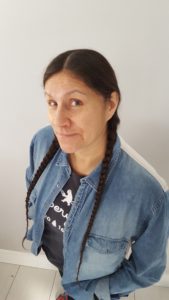We are pleased to announce that Dr Dolleen R. Tisawii’ashii Manning of McGill University will be one of the keynote speakers at CATR2018.
 Dolleen R. Tisawii’ashii Manning (Ojibwe/Potawatomi) is a member of Kettle and Stoney Point First Nation, an artist, scholar, and the youngest of twelve. Her Indigenous life-teachings, scholarly and creative work are integrally interwoven. Currently, she resides in Montreal and holds a postdoctoral fellowship with the International Institute for Critical Studies in Improvisation (IICSI), conducted at the IICSI-associated Institute for the Public Life of Arts and Ideas (IPLAI) at McGill University. Recently, she received her PhD from the Centre for the Study of Theory and Criticism at the University of Western Ontario, and holds graduate degrees in contemporary art (MFA, Simon Fraser, 1997) and critical theory (MA, Western, 2005). Manning works at the intersection of Anishinaabe ontology and epistemology, critical theory, phenomenology, and art. Her dissertation Mnidoo-Worlding: Merleau-Ponty and Anishinaabe Philosophical Translations, turns to Ojibwe concepts such as mnidoo or manitou (other-than-human person/spirit) to propose an interrelational theory of consciousness that involves a possession by these living potencies. This possession transmits to Anishinaabe visional modes and the experience of time and imaging itself. Her publications include “The Becoming-Human of Buffalo Bill” in Intensities and Lines of Flight (Calcagno, et al, eds., 2014), and “The Murmuration of Birds: An Ojibwe Ontology of Mnidoo-Worlding” in Feminist Phenomenology Futures (Fielding and Olkowksi, eds., fall 2017).
Dolleen R. Tisawii’ashii Manning (Ojibwe/Potawatomi) is a member of Kettle and Stoney Point First Nation, an artist, scholar, and the youngest of twelve. Her Indigenous life-teachings, scholarly and creative work are integrally interwoven. Currently, she resides in Montreal and holds a postdoctoral fellowship with the International Institute for Critical Studies in Improvisation (IICSI), conducted at the IICSI-associated Institute for the Public Life of Arts and Ideas (IPLAI) at McGill University. Recently, she received her PhD from the Centre for the Study of Theory and Criticism at the University of Western Ontario, and holds graduate degrees in contemporary art (MFA, Simon Fraser, 1997) and critical theory (MA, Western, 2005). Manning works at the intersection of Anishinaabe ontology and epistemology, critical theory, phenomenology, and art. Her dissertation Mnidoo-Worlding: Merleau-Ponty and Anishinaabe Philosophical Translations, turns to Ojibwe concepts such as mnidoo or manitou (other-than-human person/spirit) to propose an interrelational theory of consciousness that involves a possession by these living potencies. This possession transmits to Anishinaabe visional modes and the experience of time and imaging itself. Her publications include “The Becoming-Human of Buffalo Bill” in Intensities and Lines of Flight (Calcagno, et al, eds., 2014), and “The Murmuration of Birds: An Ojibwe Ontology of Mnidoo-Worlding” in Feminist Phenomenology Futures (Fielding and Olkowksi, eds., fall 2017).
Manning’s current research project—Anishinaabe Imaging Practices: Intuiting Across Other-Than-Human Spheres—asks how Anishinaabe philosophy, dream-visioning and imaging-practices enact complex integrative knowledges and interrelational ethics. This work builds on my theoretical research by undertaking consciousness as harmonic imaging to be explored primarily through embodied, place-based and practiced-based creative approaches. Dream informed environment-contact improvisations are workshopped and developed as participants engage place through subtle vocal experimentation, movement, touch, and land-based skills such as hunting ideogram interpretations, as participants choose. This tactile relationship to place is reciprocally navigated with kinship establishing celebrations through dream, vision, song, dance, rhythm, and sacrifice that both form the method and are the foci of this research.

